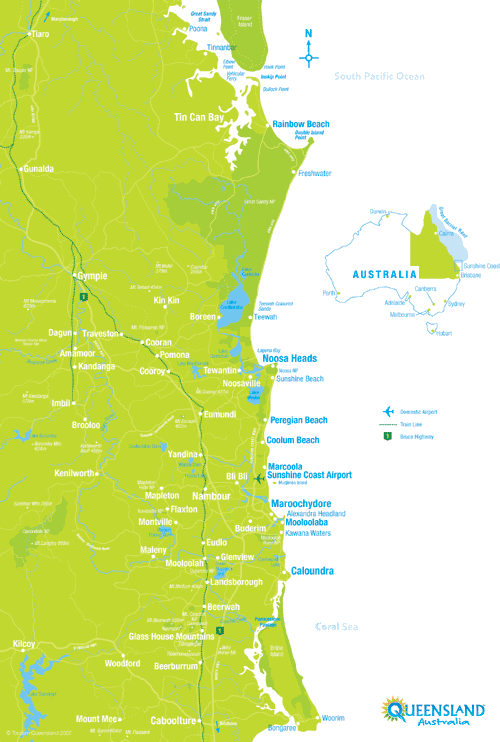General Information
The Glass House Mountains, located south-west of Caloundra, were first sighted by Jmaes Cookfrom the deck of HM Bark Endeavour in 1770.
In the 1820s, the Sunshine Coast saw its first white inhabitants: three castaways (Finnegan, Pamphlet and Parsons) who shared the life of the local (Kabi Kabi) Aborigines for eight months. Thereafter, during the 1830s to 1840s, the district became home to numerous runaway convicts, being only slightly north of Moreton Bay (Brisbane) penal colony.
In 1842, Governor George Gipps had the entire Sunshine Coast and hinterland from Mt Beerwah north to roughly Eumundi declared a ‘Bunya Bunya Reserve’ for the protection of the bunya tree, having been advised of the Aboriginal importance of bunya groves by Andrew Petrie. However, during the 1840s and 1850s, the Bunya Bunya Reserve and its vicinity became the scene of some of the most bitter skirmishes of Australia’s ‘Black War’. The Blackall Ranges, on account of the tri-annual Bunya Festival, served as both a hideout and rallying point for attacks against white settlement. By the 1850s, timber getters and cattlemen were exploiting the area and in 1860, the Bunya Bunya Reserve was scrapped.
Many of the Sunshine Coast’s towns began as simple ports or jetties for the timber industry during the 1860s and 1870s, as the area once had magnificent stands of forest. Likewise, the region’s roads often began as snigging tracks for hauling timber. Timbergetters used the region’s creeks, rivers and lakes as seaways to float out their logs of cedar – the resultant wood being shipped as far afield as Europe.
With the advent of the Gympie Gold Rush, prospectors scaled the Sunshine Coast mountains to develop easier roadways to and from the gold fields of Gympie. After construction of the railway line to Gympie, the coastal and river towns, being mostly ports for the early river trade, were bypassed.
By the 1890s, diverse small farming (fruit and dairy) replaced the cattle-and-timber economy of earlier decades. Sugar cane and pineapples proved especially important produce for the district. Many small hamlets and towns now emerged. Produce was initially taken by horse to Landsborough, then to Eudlo in 1891.
Especially after World War II, the Sunshine Coast grew into a favoured holiday and surfing destination. This tendency was further expanded in the development boom of the 1960s and 1970s. Around the same time, various tourist/ theme parks were created – the most iconic being Woombye’s ‘Big Pineapple.’ During the 1960s and 1970s, the Sunshine Coast also attracted persons drawn to Alternative lifestyles. These newcomers developed a range of craft industries, co-operatives and spiritual centres, particularly in the hinterlands.
After the 1980s, the Sunshine Coast experienced rapid population growth. It is now one of the fastest-growing regions in Australia. As the region becomes increasingly residential, most of the district’s distinctive small farms – especially tropical fruit farms – have disappeared, as have most of its theme parks. Instead, businesses concerned with retail, catering and tourism have assumed increasing importance.
Beaches
Several stretches of the Sunshine Coast are lined with unbroken beaches – from Sunhine Beach near Noosa to Coolum Beach (17 km (11 mi)); the coast from Point Arkwright to Mudjimba(11 km (6.8 mi)); the Maroochydore-Mooloolaba stretch (5.6 km (3.5 mi)); and from Buddina past the Caloundra CBD to Pelican Waters(22 km (14 mi)). Notable beaches include:
- Noosa Main Beach
- Coolum
- Maroochydore
- Alexander Headland
- Mooloolaba
- KAwana Waters
- Kings Beach in Caloundra
Tourism
The Sunshine Coast is a centre for tourism, containing attractions such as Steve Irwins Australia Zoo, Underwarer World world marine park, Aussie World with the Ettamogah Pub, The Buderim Gimnger Factory, The Big Pineappleand the Majestic Theatre at Pomona.
Sports tourism is supported by several annual sporting events such as Mooloolaba Triathlon (March), Noosa Triathlon (October) and Sunshine Coast Marathon (August)

